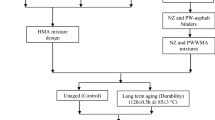Abstract
This paper investigates the influence of mixture morphologies and microstructures on oxidative ageing of asphalt mixtures. For this, an oxidative ageing mechanism based on a diffusion–reaction process was developed. Previously, most asphalt oxidative ageing modeling research focused on unidirectional diffusion of continuous oxygen flow through bitumen films, which is far from the actual boundary conditions in asphalt mixtures. For this reason in the current study, a finite element (FE) analysis has been conducted in which 3D mixture morphology was considered. Mixture morphology is the combination of mineral aggregate packing, porosity, air-void distribution and their interconnectivity. One dense and one open graded field asphalt mixture core were scanned with a computerized tomography X-ray scanner. In the analyses, the developed oxidative ageing model was implemented. The FE analysis showed that the effect of the air-void distribution, their interconnectivity and the mineral aggregate packing has a significant effect on the resulting age hardening of the overall mixture. Furthermore, from the microstructural investigation done in this research, strong indications were found that, depending on the bitumen and its conditioning, water soluble thin films are formed due to ageing. This means that ageing and moisture damage are strongly interlinked and this should thus be considered in the design of the asphaltic materials and the prediction of their long term performance.


















Similar content being viewed by others
References
Allen RG, Little DN, Bhasin A (2012) Structural characterization of micromechanical properties in asphalt using atomic force microscopy. J Mater Civ Eng 24(10):1317–1327
Woo WJ, Chowdhury A, Glover CJ (2008) Field aging of unmodified asphalt binder in three texas long-term performance pavements. J Transp Res Board 2051:15–22
Petersen JC (2007) A dual, sequential mechanism for the oxidation of petroleum asphalts. Pet Sci Technol 16(9–10):1023–1059
Petersen JC (1993) Asphalt oxidation—an overview including a new model for oxidation proposing that physicochemical factors dominate the oxidation kinematics. Fuel Sci Technol Int 11:57–87
Van Oort WP (1956) Durability of asphalt-it’s aging in the dark. Ind Eng Chem 48(7):1196–1201
Dickinson EJ (1984) The diffusion controlled reaction of oxygen with films of bituminous binders. Aust Road Res 14:121–132
Tuffour YA, Ishai I (1990) The diffusion model and asphalt age-hardening. Proc AAPT 59:73–92
Dickinson EJ (2000) Prediction of the hardening of the bitumen in pavement surfacings by reaction with atmospheric oxygen. Int J Road Mater Pavement Des 1(3):255–280
Herrington PR, Henderson R (2004) Bitumen film thicknesses and confinement ratios in chip seal surfacings. Intl J Road Mater Pavement Des 5(2):251–264
Herrington PR (2012) Diffusion and reaction of oxygen in bitumen films. Fuel 94:86–92
Glaser RR, Schabron JF, Turner TF, Planche J-P, Salmans SL, Loveridge JL (2013) Low-temperature oxidation kinetics of asphalt binders. Transp Res Record 2370:63–68
Han R, Jin X, Glover CJ (2013) Oxygen diffusivity in asphalts and mastics. Pet Sci Technol 31(15):1563–1573
Crank J (1975) The mathematics of diffusion, 2nd edn. Oxford University Press, Oxford
Onifade I, Jelagin D, Guarin A, Birgisson B, Kringos N (2013) Asphalt internal structure characterization with X-ray computed tomography and digital image processing. In: Kringos N, Birgisson B, Frost D, Wang L (eds) Multi-scale modeling and characterization of infrastructure materials, chapter: 11. Springer, Netherlands, pp 139–158
Farrar MJ, Harnsberger PM, Thomas KP, Wiser W (2006) Evaluation of oxidation in asphalt pavement test sections after four years of service. Proceedings of the international conference on perpetual pavement, Columbus, Ohio
Loeber L, Sutton O, Morel J, Valleton J-M, Muller G (1996) New direct observations of asphalts and asphalt binders by scanning electron microscopy and atomic force microscopy. J Microsc 182(1):32–39
Pauli AT, Branthaver JF, Robertson RE, Grimes W, Eggleston CM (2001) Atomic force microscopy investigation of SHRP asphalts. ACS Div Fuel Chem Prepr 46(2):104–110
Masson J-F, Leblond V, Margeson J, Bundalo-Perc S (2006) Bitumen morphologies by phasedetection atomic force microscopy. J Microsc 221:17–29
Das PK, Kringos N, Wallqvist V, Birgisson B (2013) Micromechanical investigation of phase separation in bitumen by combining AFM with DSC results. Road Mater Pavement Des 14(S1):25–37
Das PK, Kringos N, Birgisson B (2014) Micro-scale investigation of thin film surface ageing of bitumen. J Microsc. doi:10.1111/jmi.12122
Lu X, Redelius P (2006) Compositional and structural characterization of waxes isolated from bitumens. Energy Fuels 20:653–660
Redelius P (2004) Bitumen solubility model using Hansen solubility parameter. Energy Fuels 18:1087–1092
Kringos N (2007) Modeling of combined physical-mechanical moisture induced damage in asphaltic mixes. PhD dissertation, TU Delft, ISBN:978-90-9021765-9
Acknowledgments
The authors gratefully acknowledge the financial support of the Swedish Transport Administration (Trafikverket). Furthermore, the advice of Måns Collin regarding the micro-scale mechanism and the assistance of Alvaro Guarin and Ibrahim Onifade in the scanning of the asphalt mixture cores is kindly acknowledged.
Author information
Authors and Affiliations
Corresponding author
Rights and permissions
About this article
Cite this article
Das, P.K., Balieu, R., Kringos, N. et al. On the oxidative ageing mechanism and its effect on asphalt mixtures morphology. Mater Struct 48, 3113–3127 (2015). https://doi.org/10.1617/s11527-014-0385-5
Received:
Accepted:
Published:
Issue Date:
DOI: https://doi.org/10.1617/s11527-014-0385-5




